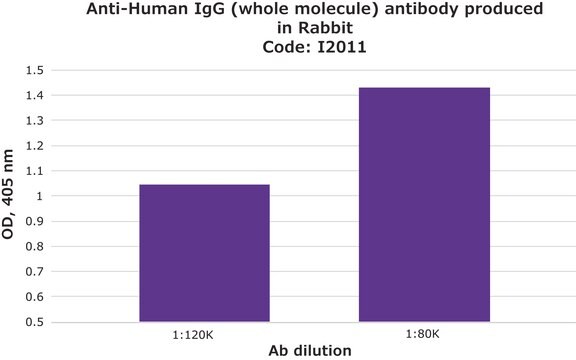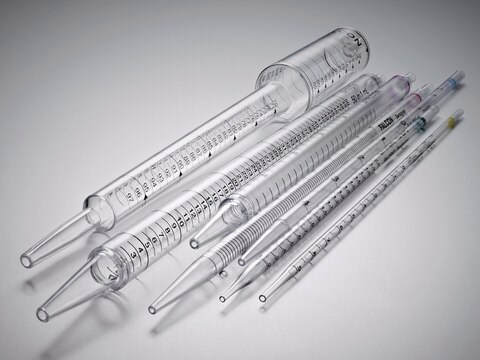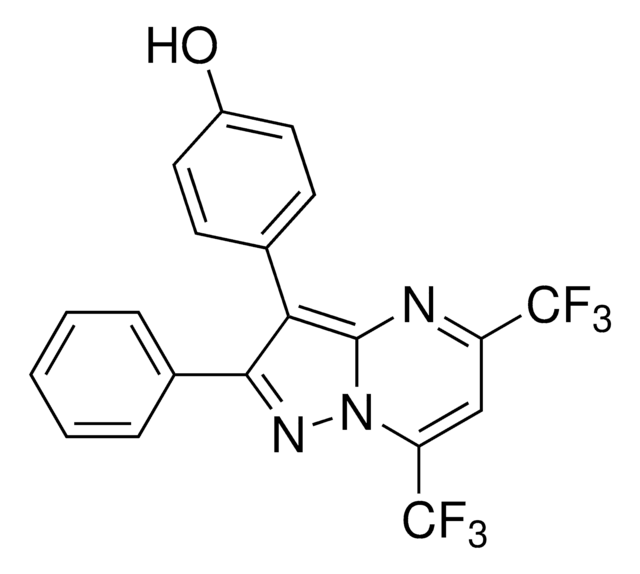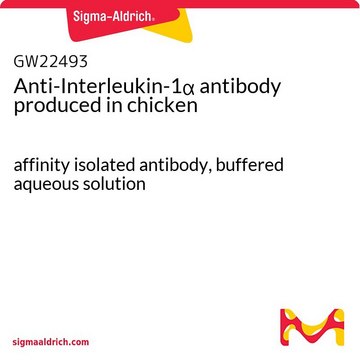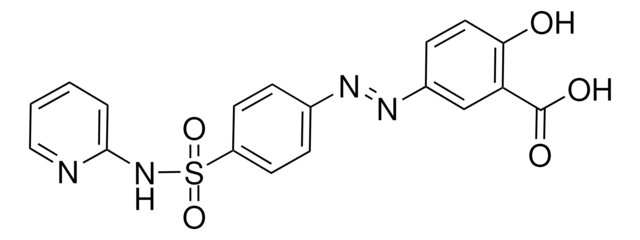I3392
Anti-Interleukin-1α antibody produced in goat
IgG fraction of antiserum, lyophilized powder
Synonym(s):
Anti-IL-1α
Sign Into View Organizational & Contract Pricing
All Photos(1)
About This Item
Recommended Products
biological source
goat
Quality Level
conjugate
unconjugated
antibody form
IgG fraction of antiserum
antibody product type
primary antibodies
clone
polyclonal
form
lyophilized powder
species reactivity
mouse
technique(s)
indirect ELISA: suitable
neutralization: suitable
western blot: suitable
UniProt accession no.
storage temp.
−20°C
Gene Information
mouse ... Il1a(16175)
Looking for similar products? Visit Product Comparison Guide
Related Categories
General description
Interleukins are proinflammatory cytokines produced on cell injury or trauma. There are two closely related types of interleukins produced by the cell, IL-1α and IL-1β that are produced by the activation of NF-κ B transcription factor in response to bacterial infection or LPS. Both IL-1α and IL-1β exert their cellular effects by signalling through IL-1 receptor type 1. A variety of cells such as macrophages, epithelial cells, fibroblasts, keratinocytes, monocytes and dendritic cells secrete IL-1α. Both IL-1α and IL-1β are important in acquired immunity, inflammation, response to infection and production of matrix metalloproteinases (MMPs). The effects of IL-1α are mediated by activation of NF-κB, JNK and MAPK pathways that activated the genes in response to infection and inflammation. Overproduction of IL-1α has been implicated in inflammatory disorders like rheumatoid arthritis and periodontitis
Anti-interleukin-1α specifically reacts with mouse IL-1α. It does not react with human IL-1α and IL-1β or mouse IL-1β.
Anti-interleukin-1α specifically reacts with mouse IL-1α. It does not react with human IL-1α and IL-1β or mouse IL-1β.
Specificity
The antibody will neutralize the biological activity of recombinant mouse IL-1α, but not recombinant human IL-1α, IL-1β or recombinant mouse IL-1β.
Immunogen
recombinant mouse IL-1α.
Application
Anti-interleukin 1α antibody is suitable for neutralization reactions and the recommended ND50 is 0.04-0.2 μg/ml. The antibody may be used for immunoblotting at a working concentration of 1-2 μg/ml. It is also suitable for indirect ELISA applications.
Physical form
Lyophilized from a 0.2 μm filtered solution in phosphate buffered saline pH 7.4, with 5% trehalose.
Disclaimer
Unless otherwise stated in our catalog or other company documentation accompanying the product(s), our products are intended for research use only and are not to be used for any other purpose, which includes but is not limited to, unauthorized commercial uses, in vitro diagnostic uses, ex vivo or in vivo therapeutic uses or any type of consumption or application to humans or animals.
Not finding the right product?
Try our Product Selector Tool.
related product
Product No.
Description
Pricing
Storage Class Code
11 - Combustible Solids
WGK
WGK 1
Flash Point(F)
Not applicable
Flash Point(C)
Not applicable
Personal Protective Equipment
dust mask type N95 (US), Eyeshields, Gloves
Choose from one of the most recent versions:
Already Own This Product?
Find documentation for the products that you have recently purchased in the Document Library.
Interleukin-1 (IL-1) pathway
Weber A et al
Science Signaling, 3, p-p (2010)
Eun-Bum Kang et al.
Apoptosis : an international journal on programmed cell death, 18(11), 1332-1347 (2013-08-03)
Alzheimer's disease (AD) is characterized by the deposition of aggregated amyloid-beta (Aβ), which triggers a cellular stress response called the unfolded protein response (UPR). The UPR signaling pathway is a cellular defense system for dealing with the accumulation of misfolded
S Z Ben-Sasson et al.
Cytokine, 56(1), 122-125 (2011-08-17)
IL-1 strikingly enhances antigen-driven responses of CD4 and CD8 T cells. It is substantially more effective than LPS and when added to a priming regime of antigen plus LPS, it strikingly enhances cell expansion. The effect is mediated by direct
Charles A Dinarello
Current opinion in pharmacology, 4(4), 378-385 (2004-07-15)
All biological agents currently used for reducing TNFalpha activity in disease are neutralization strategies; however, there are several strategies for reducing interleukin (IL)-1 activities: the IL-1 receptor antagonist (IL-1Ra), anti-IL-1beta monoclonal antibodies, the IL-1 Trap, IL-1 receptor type I antibodies
Emmanuel Contassot et al.
Swiss medical weekly, 142, w13590-w13590 (2012-06-02)
Interleukin 1, one of the first cytokines discovered in the 1980s, and a potent mediator of fever, pain and inflammation, is at present experiencing a revival in biology and medicine. Whereas the mechanism of activation and secretion of interleukin 1β
Our team of scientists has experience in all areas of research including Life Science, Material Science, Chemical Synthesis, Chromatography, Analytical and many others.
Contact Technical Service
